CDMX (Mexico City)
Tourism in CDMX
México City is the capital of the Mexican Republic and has become the financial, cultural and political center of the country. It is one of the biggest and most populated cities in the world. To speak of Mexico City (CDMX) is to imagine one of the most populated cities in the world, where avenues, viaducts, causeways, alleys and streets become arteries where its inhabitants are the lifeblood of this great city. But Mexico City has a characteristic that makes it very attractive for tourism: its great history, art and its beautiful colonial and contemporary architecture.
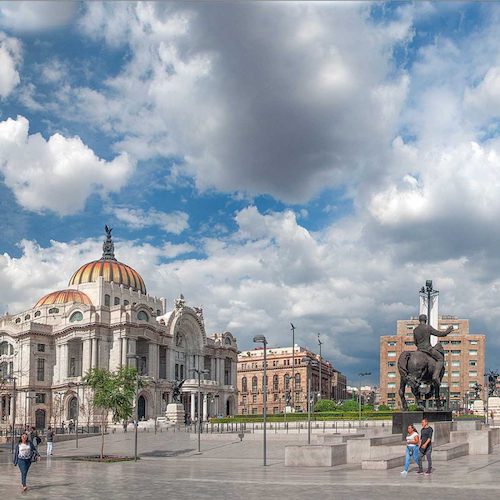
When walking through the Historic Center of Mexico City you can realize the baroque, neoclassical style and relics of our Aztec ancestors such as the same main temple next to the metropolitan cathedral.
Examples of areas and places to visit in Mexico City abound and it is a pleasure to explore them on foot, especially picturesque neighborhoods such as San Angel or Coyoacán or Paseo de la Reforma itself, the financial, cultural and political center of the country where you can also find the famous Independence Monument inaugurated in 1910, an internationally recognized emblem of this city.
Mexico City has an infinite number of entertainment options. It is enough to know that there are 132 museums, 7 nearby archaeological zones and 64 theaters, not to mention the clubs, bars and restaurants serving all kinds of Mexican and international food.
Seven hundred years of history can also be appreciated among its great avenues, speedways, boulevards and skyscrapers; this is why the city shows several expressions of its traditional roots evoking a native and colonial past, together with the most refined art and architectural expressions reflecting modernity and the potential future of a growing metropolis.
Its pre-Hispanic remains show the greatness of the first civilizations settled on this site. Colonial architecture in its purest Baroque and neoclassic styles exemplify the blending of races, combining the natives carving work with the greatness of the European constructions. There are plenty of these examples along the city, sober and sumptuous temples, old residences and convents. Its suburbs like Coyoacán, San Angel or Tlalpan have a picturesque and unique style.
For those who love art and history, there is a great deal of options including around 188 museums, 64 theaters, 15 cultural centers and 7 nearby archaeological zones.As a typical cosmopolitan city, Mexico City has a frenzied activity, not only during the day but at night too.
Regarding touristic facilities, the city has countless luxury hotels, sophisticated restaurants and a great variety of stores with items for all tastes and economies. Climate is moderate sub-humid with 15°C average year temperature.
Tourist Attractions in IN CDMX
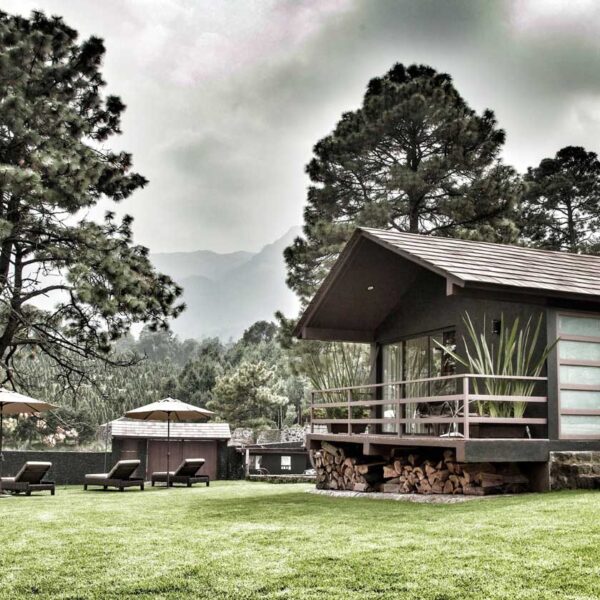
Ecotourism and Adventure in CDMX
Ecotourism is one of the main economic activities in Mexico and the world, this is because every day more people move from their place of residence to other destinations with different objectives. For this reason and for the sector to meet the needs of each type of visitor, tourism has chosen to differentiate itself taking into account what motivates people to travel. On this occasion we will focus on ecotourism and yes, although many do not imagine that within this great city there is space for areas destined for this activity in Mexico City there is an offer for travelers who seek to coexist with the environment. Ecotourism takes place in natural areas and its purpose is the appreciation and knowledge of nature.… Read More
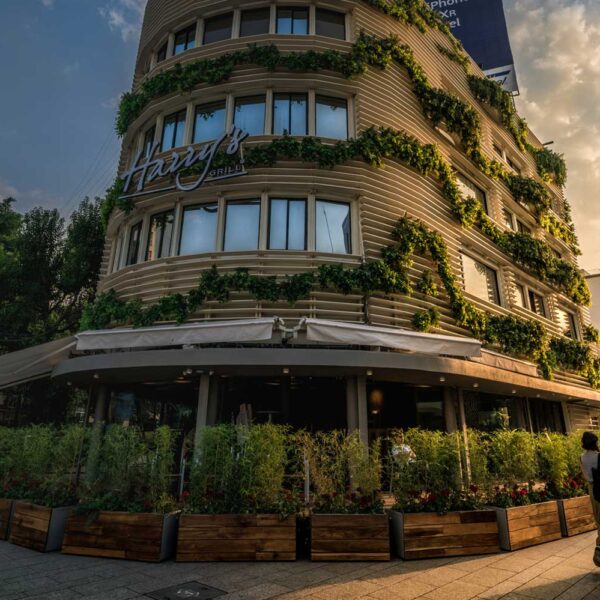
Polanco – Lomas de Chapultepec (CDMX)
At the end of Paseo de la Reforma Avenue looms Chapultepec hill, on the top is a beautiful ancient castle surrounded by the centuries-old forest, world-class museums, amusement parks, a zoo and lakes. This is the perfect place to share a good time with your family. This is an upmarket neighborhood. It houses the offices of international organizations, embassies, and the offices of many corporations, as well as upscale hotels, designer shops, modern malls, gourmet restaurants, and art galleries. The perfect place to pamper yourself!… Read More
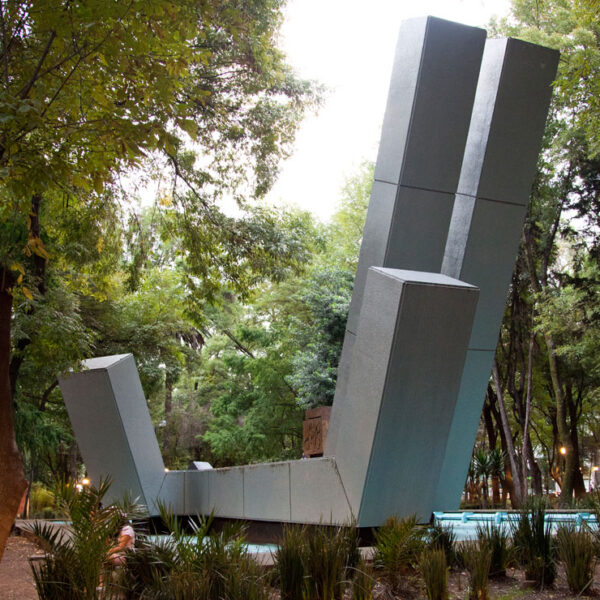
Condesa – Roma – Zona Rosa (CDMX)
For hipsters, artists, and people who like bohemian and intellectual atmosphere this area is a must- see attraction. The three different districts offer unique places. Zona Rosa is a neighborhood known for its shopping, nightlife and restaurants, which cater to foreign and Mexican visitors, as well as businessmen of the nearby Paseo de la Reforma.… Read More
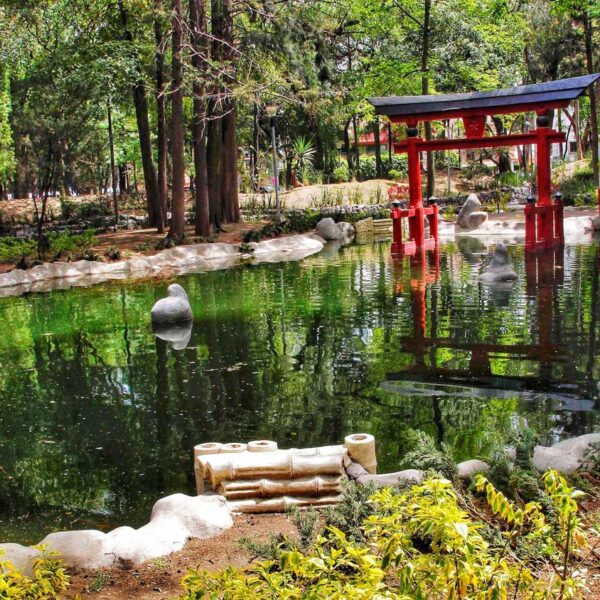
Coyoacan (CDMX)
Stunningly beautiful neighborhood of cobblestone streets lined by massive old trees defined by their small plazas and Colonial-Era homes with boutiques, galleries, ancient churches, restaurants with nice outdoor terraces, bookstores, and cafes. This whole area is infused with a particular international feeling that lends a bohemian touch to the neighborhoods where many intellectuals and artists have lived, like León Trotsky, Octavio Paz, Diego Rivera, Frida Kahlo and Salvador Novo. Theaters, jugglers, mime artists, street musicians, paintings and sculptures display in the plazas, are just some of the cultural activities around this area. Here, visitors find a little of the old, provincial Mexico.… Read More
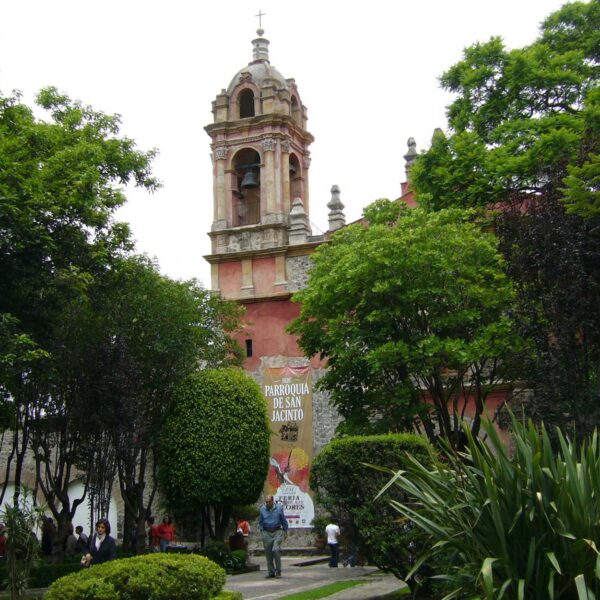
San Angel (CDMX)
This neighborhood has been kept in a time capsule. The beautiful plazas, narrow cobblestone streets, and old colorful houses with elaborate balconies, maintain an authentic colonial atmosphere. Today San Angel also features many exclusive boutiques and art galleries. Restaurants where you can enjoy outdoor dining on beautiful patios or terraces that surround plaza De San Jacinto. The square is best known for its Saturday art bazaar. High-quality handicrafts, antiques, art, and Mexican food are all offered here. Since 2010 San Ángel urban architecture (streets, squares, churches, convents, etc), became the city’s first Tangible Cultural Heritage of Mexico City and the cultural expressions manifested in the neighborhood as Intangible Cultural Heritage.… Read More
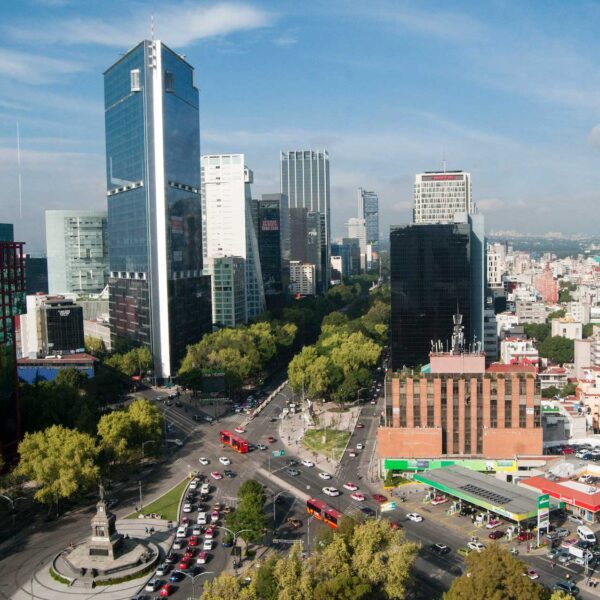
Insurgentes Area (CDMX)
One of the main arteries of the city: “La Avenida Insurgentes”. The formerly known as “Via del Centenario”, has become a reference for location, commerce and tourism. With its almost 29 kilometers in length, it offers a large number of options and activities for tourism. On the avenue, there are historical monuments, cultural and commercial buildings, parks, etc. If you are planning a business or pleasure visit to Mexico City, or you live in this great city, do not hesitate and take a tour of Avenida Insurgentes, either day or night, surely you will find a wide variety of activities of great interest.… Read More
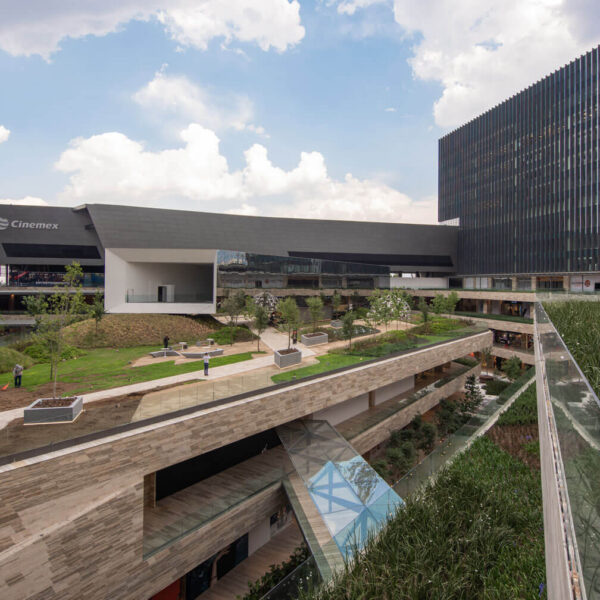
South of The City (CDMX)
The southern part of Mexico City is made up of 5 delegations that are Milpa Alta, Xochimilco, Tlahuac, Tlalpan and Coyoacán. Many places of interest are located in this area of the city. Beautiful parks and forests, gardens on the water, museums, theaters, markets, culture, history and entertainment are just some examples of the diversity that can be found in this part of the city.… Read More
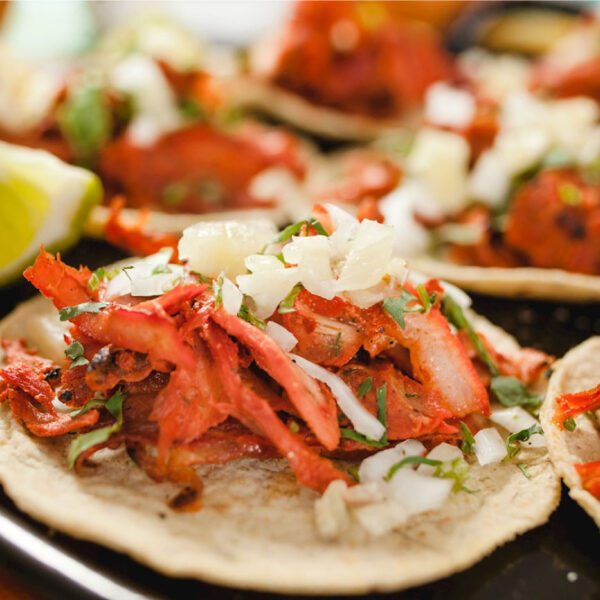
Gastronomy of CDMX
The gastronomy of Mexico City will surprise you, there are no limits to the creativity of the chefs who create rich options, trying them will be a unique experience worth enjoying, you just have to cheer up, you won’t regret it!… Read More
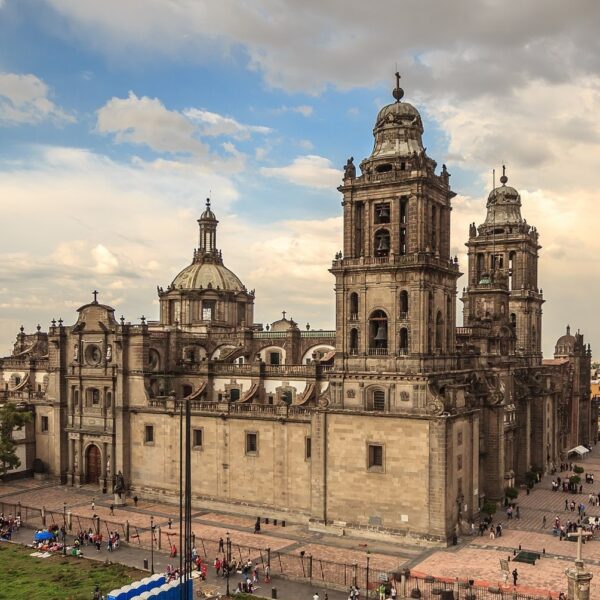
Historic Center (CDMX)
The Historic Center is a UNESCO world heritage site that was once the capital of the ancient Aztec empire and then the seat of power for the Spanish colony of New Spain. It contains more than 2,000 buildings of historical importance and an impressive archeological site. Many of these buildings are shrouded in magic and legend. You may walk along the streets filled with history, and come across luxury hotels, impressive museums, five-star restaurants, department stores with more than a hundred-year-old history, beautifully decorated churches and monuments.
… Read More
What to do in CDMX
Panoramic views of the city
There are several options to admire the city and be amazed for its colossal size. Torre Latinoamericana offers spectacular views of the city’s heart, from the 44th-floor observation deck and a nice restaurant in the 41st floor. Other fantastic places to admire the city are: Torre Mayor, the tallest building in the city, the dome of the Monument of the Revolution, the restaurant located at the top of the World Trade Center and the terrace of Chapultepec Castle.
Historic Center, of Mexico City
A UNESCO World Heritage Site. This ten-acre area is home to numerous historical buildings, museums and the Templo Mayor. The baroque art in the various churches will amazed you, starting with the Metropolitan Cathedral. A perfect way to end the day is trying a famous Mexican dish or a refreshing drink on one of the terraces overlooking the zócalo.
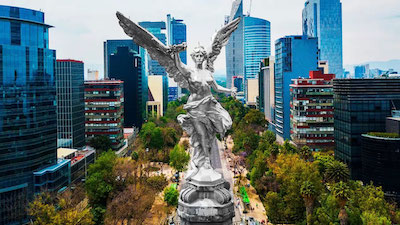
The Palace of Fine Arts and a great Park full of History
Visit the Palace of Fine Arts, City’s premier arts institution and one of its architectural landmarks with amazing murals and the famous stage curtain which is a stained glass foldable panel created out of nearly a million pieces of iridescent colored glass by Tiffany’s in New York. The theater hosts Mexican and foreign operas as well as performances of classical music, ballet and Mexican folk music on Sundays.
Check ahead of your visit for program details. Don’t miss the Arts & Crafts Store. In front is the Alameda Park, a shady and beautifully kept park with many splendid fountains and sculptures and the oldest park in America, surrounded by attractions such as the Diego Rivera Mural Museum, the Museum of Memory and Tolerance, the National Museum of the Stamp, the Franz Mayer Museum and the beautiful Postal Palace.
Hipster, gourmand, eclectic and/or vintage you’re going to love La Condesa / Roma
In recent years, antique showrooms, sidewalk cafes, bars and boutiques have opened along these two bohemian neighborhoods, filled with fading 1920s and 1930s architecture. If you love cultural life you can visit Casa Lamm, the Museo del Objeto del Objeto, the Museo Universitario de Ciencia y Arte and the Museo Casa del Poeta Ramón López Velarde. Neighborhoods are home to Mexico City’s trendy and creative gastronomy. The area overflows with diverse dining options and alluring nightlife possibilities.
There are restaurants that make you feel in Soho, New York, or the Mercado Roma that has become the place to sample the city’s diverse culinary scene, with 60-odd vendors serving everything from squid tortas to tangy ceviches to tamarind-flavored truffles. If you are a natural shopper you will love the weekend markets. The Pushkin Park tianguis offers natural products, cosmetics, jewelry and much more. The Bazar de Oro, near Cibeles Fountain, where you can find unique clothing, accessories, organic products and curiosities.
The Art Corridor on Avenida Álvaro Obregón, Roma’s main drag, entice crowds to stroll down the tree- shaded street to find various works of art. The Bazarte Obregon in Ramón López Velarde Park with clothing, accessories, antiques and street stalls offering gourmet food. The Cuauhtémoc Tianguis in Plaza Dr. Ignacio Chávez, offer antiques and unusual objects such as comics, books, toys and some other pieces 100% vintage.
Urban Ecology
Bicycle riding is today a popular way to get around the city, especially on Sunday mornings, when city hall shuts major throughways like Reforma, one of the most beautiful avenues in the city. And walk through the Garden of Art, located off Reforma, includes a huge variety of art that will appeal to everyone.
Music, museums and entertainment
The University Cultural Center is a big draw thanks to the performances in its spectacular concert hall, Sala Nezahualcóyotl, as well as being home to a wide range of exhibits and the National Library. The Cultural Center is also home to museums like the University Museum of Contemporary Art and the Universum Museum, one of the country’s best science museums where kids are encouraged to participate.
Chapultepec
The world’s largest park within a city, perfect for the entire family. Take a stroll around the forest trails and in the lake rent a pedal boat or a rowboat, visit the zoo, the Papalote Children’s Museum, the Museum of Technology and of course the old style fair.
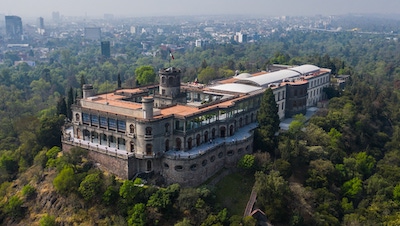
A Forest and a Castle
Live the experience of visiting the hilltop Chapultepec Castle that houses de National Museum of History and learn about the most representative of Mexico historical heritage through times, and enjoy the checkerboard marble terraces, the fountains and tremendous views. Then continue to the amazing Museo Nacional de Antropología (National Anthropology Museum), which is a must if you want to learn about Mexican Pre-Hispanic culture, the Tamayo Museum and the Modern Art Museum.
Enthusiasts for fashion & gourmet experiences
Chic Polanco district offers the perfect destination for food and shopping lovers. Presidente Masaryk Avenue has the charm and walkability factor of a European city and is full of elegant and high-end shops and restaurants.
Art and underwater world
Enjoy one of the best art collections in the world in the Soumaya Museum and continue with the Jumex Museum located just across the street, featuring the largest private contemporary arts collection in Latin America, both with stunning architectural design. Next to Soumaya Museum is the largest aquarium in Latin America with over 5,000 marine species, it’s just as if you took a trip around the entire oceans of the world!
Travel through channels as in pre-Hispanic times.
In the South of The City hundreds of “trajineras” await passengers at the village’s nine embarcaderos (boat landings). You can board the colorful open-air boats, to take a trip down the waterways to a wildlife preserve and floating gardens. The experience comes with boats with mariachi bands and some others sell beer, soda, water, and different types of Mexican food like tacos, sopes, or fish. For thrill-seekers is the haunted Island of the Dolls where thousands of mutilated dolls hang from the trees and hide among the dense branches.
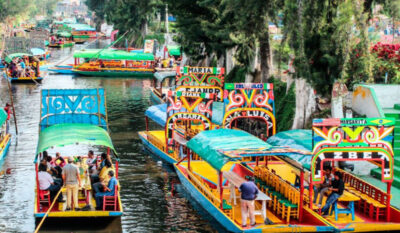
Art and Flowers
San Ángel, once a weekend retreat for Spanish nobles has become a stunningly beautiful neighborhood of cobblestone streets and Colonial-Era homes, with several worthwhile museums. Visitors are attracted to brightly colored flowers and just in front is the 17th century Templo de El Carmen, and next to the church is the former convent that has become a museum that showcases some mummies on display in the basement.
Not very far is the Plaza del Carmen, surrounded by some restaurants and a number of historic buildings such as the Centro Cultural San Angel and Casa Jaime Sabines. On Saturday, San Ángel turns into a giant crafts market, overflowing with vendors, customers and an enormous selection of handiwork.
The activities begin in the Plaza del Carmen, continues in the beautiful Amargura Street and ends in the Plaza San Jacinto with dozens of stalls offering dresses, handicrafts, antiques, paintings, sculptures and everything you can imagine, beside is the renowned Bazar del Sábado (Saturday Bazaar) full of artistic and antique treasures and surrounded by excellent restaurants and cantinas.
Overlooking the Plaza San Jacinto are some restaurants, the ethereal Iglesia San Jacinto, a 16th-century church with an exquisite baroque altar and Casa del Risco with an original mosaic fountain made from abalone shells, Chinese porcelain and Talavera ceramic plates from Puebla.
Guadalupanos
Visit the Tepeyac Hill and feel the incredible devotion of the Mexican people towards the Virgin of Guadalupe. Starting with the Capilla del Cerrito, built on the spot where St Juan Diego first saw the Blessed Virgin. Continue with the Basilica de Guadalupe, the second most visited pilgrimage site in the world, next is the Basilica Museum with an incredible collection of religious art.
Cultural Nights
Every last Wednesday of the month, more than one-third of Mexico City’s museums will re-open their doors one or two hours after the normal closing time, and add special events to their normal offerings, such as: concerts, guided tours, workshops or film screenings. To learn more about the museums and the activities: http://data.cultura.cdmx.gob.mx/nochedemuseos/ or follow the museums social media.
Santa Fe
Santa Fe is Mexico City’s newest and most modern neighborhood, it has become the major business district in the city. It looks more like a modern American neighborhood than anywhere else in Mexico City.
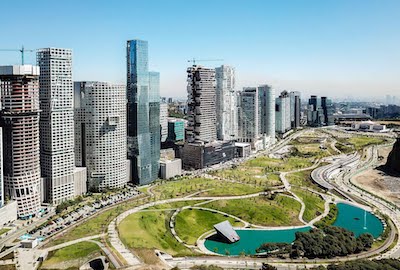
Right in the heart of Santa Fe is Park La Mexicana with 28 hectares, it has a system for collecting rainwater, lighting, surveillance, free Wi-Fi, spaces for children, hammocks, a cycle path, a skate park, sports courts, open cultural areas, a pet area, two lakes and three wetlands. It is an excellent area to hang out with your family.
Set in the rolling hills west of the city, Santa Fe includes a collection of hypermodern mirrored glass and steel towers containing luxury condos and office buildings, banks, college campuses, the largest shopping complex in Latin America which includes everything from ice rinks (offering hockey and skating classes) to prestigious boutiques, cinemas, restaurants, children’s play areas and almost 300 stores to browse through.
Expo Santa Fe is an Exhibit and Convention Center of international quality, strategically located in Santa Fe. It offers the ideal characteristic to hold all types of trade shows and expos, as well as events of a commercial or social nature, and it is considered one of the best venues in the country.
Coyoacán
Cotoacán was an autonomous town outside the metropolis for several centuries. Here you walk through its peaceful streets, colonial- style mansions, cobblestone streets, flowering bougainvillea, ancient jacaranda trees, and picturesque churches. Consider starting your journey with a trip aboard Coyoacan’s touristic tram and learn all about the attractions, ghost stories and legends.
Visit Frida Kahlo’s Blue House, that offer insight into her life as a wife, lover and artist, and the Museo de Arte Popular (Popular Art Museum), where you can appreciate the rich colors and the creativity of the craftsmen. By the end of the afternoon, you can enjoy the outdoor cafes and restaurants with bohemian and intellectual atmosphere or visit one of the famous canteens in the center of Coyoacán.
More Interesting Sites in CDMX
El Cementerio del Tepeyac (Tepeyac Graveyard)
It is the only cemetery that dates back to the viceregal period and continues to function. There is a list of notable individuals buried at this historic cemetery.
Basilica of Our Lady of Guadalupe
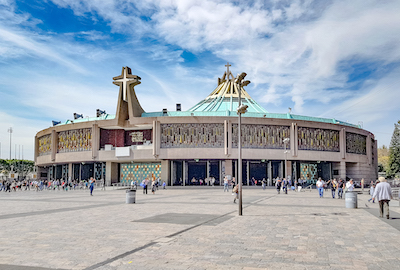
This is the second most visited Catholic sanctuary in the world with almost 20 million of pilgrims every year. The enormous modern church can hold up to 10,000 worshippers inside, and the immense plaza in front of the basilica has room for 50 000 worshipers. The new Basilica has a vast, rounded interior space, so the image of the Virgin can be viewed from many perspectives.
Capilla del Pocito (Chapel of the Well)
A unique circular structure with a trio of tiled cupolas, built in 1787 to commemorate the miraculous appearance of a spring where the Virgin of Guadalupe had stood. The pilgrims attributed curative properties to the spring and the church is a jewel of Mexican Baroque. The high altar is surrounded by wonderful paintings of one of the most celebrated artists of viceregal Mexico, Miguel Cabrera.
Capilla del Cerrito (Hill Chapel)
It was built in 1666 on the spot where the virgin appeared to Juan Diego, at the top of the hill, although the present structure date from 1748. In its interior there is a beautiful marble altarpiece, impressive murals made by Fernando Leal, and mosaics cover a beautiful dome.
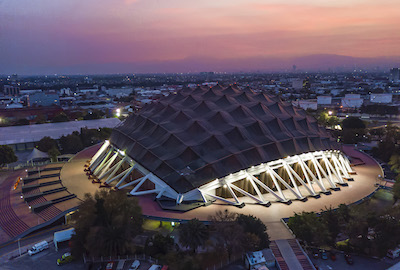
Palacio de los Deportes (Palace of Sports)
It is an indoor arena with an overall capacity of 20,000, in which sports and artistic events are also celebrated. The dome consists of hyperbolic paraboloids of tubular aluminum covered with waterproof copper-sheathed plywood.
Antigua Parroquia de Indios (Chapel of the Indians)
The hermitage was built in the middle of the seventeenth century, and it is the oldest construction in the Tepeyac Hill. It is a house in which it is said that Juan Diego lived, after the Virgin’s first appearance, until his death in 1548.
Capilla de las Rosas (Chapel of the Roses)
It is just a monument with a statue of an angel on the top of the column. It is a vestige of a demolished parish that remembers the place where the Virgin arranged the roses on the tilma (a burlap-type cloak) of Juan Diego.
Convento y Capilla de las Capuchinas (Capuchinas Convent and Chapel)
Built at the end of the 18th century it has a simple façade. It has suffered some damage over time so it had to be intervened because the construction was unstable and it was sinking.
Museums in CDMX
Museo de la Basílica de Guadalupe (Museum)
The museum features 16 rooms with a unique fine collection of colonial art interpreting the miraculous vision. The exhibit includes: linens, sheets, marble sculptures, ivory banners, jewelry, books and much more. There are also paintings of important artists such as Cristóbal de Villalpando and Miguel Cabrera, among others. In the library you can purchase unique editions. Tuesday-Sunday: 10:00-17:30 hrs.
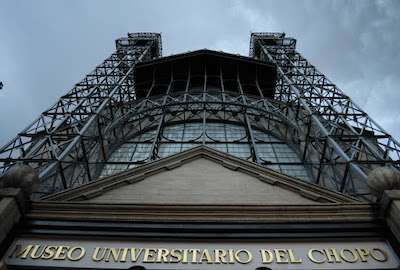
Museo Universitario El Chopo
The museum exhibits a collection related with contemporary art. The original iron and glass building is in the Jugendstil-style. It offers exhibitions and performances, including contemporary music and dance, theater, film screenings and lectures. Tuesday-Sunday: 10:00-19:00 hrs.
Museo del Fuego Nuevo (Museum of The New Fire)
The name is related with a ritual conducted in the Cerro de la Estrella during the pre-Hispanic era. This museum is the home to the Fuego Nuevo Pyramid and exhibits more than 500 archaeological pieces. There are also scenes of the daily life during the pre-Hispanic and colonial eras, as well as a Codex with a representation of the New Fire Ceremony. Tuesday-Sunday: 9:00 to 17:00 hrs.
Ex-Convent Culhuacán
The Augustinian friars built it. The monastery of San Juan Evangelista is one of the few remaining from the 16th century in Mexico City. At the higher Cloister, there is a site museum visitors can learn more about Culhuacan Pre-Hispanic and Colonial past. One of the outstanding aspects of Culhuacan Ex Convent is mural painting.
It is a sample of syncretism between European and pre- Hispanic cultures. Among the impressive frescoes the scenes of the Augustine Martyrs and the Worship of the Three Wise Men are the most prominent. Tuesday-Sunday: 9:00-17:00 hrs.
Planetario Luis Enrique Erro
It is a planetarium with a stellar dome and a digital projection system. In addition, you can visit the electromagnetism room. Monday-Sunday: 10:00-17:00 hrs.
Teotihuacán
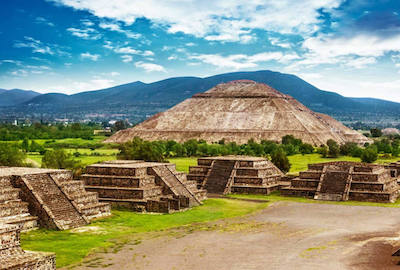
It is the oldest and one of the more majestic pre-Hispanic cities, located 40 kilometers (25 miles) northeast from Mexico City, and was designated a UNESCO World Heritage Site. Teotihuacan is a Nahuatl (Aztec) name meaning “place where gods were born”. The main structures within the Ceremonial Center are: La Ciudadela, a 400 meters side square area (1300 ft.). Inside are various structures with bas-relief executed slopes showing waving snakes with feather-covered bodies, big heads with Tláloc attributes and shells.
La Calzada de los Muertos (Avenue of the Dead), has more than 800 aligned basements. La Pirámide del Sol (Pyramid of the Sun) it used to be more than 75 meters high (250 ft.), but today it is 64 meters high (215 ft.) and it is one of the tallest pre-Hispanic buildings. Pirámide de la Luna (Pyramid of the Moon) is 44 meters high (146 ft.). Palacio de Quetzalpapalotl (Palace of the Quetzalpapalotl); its inner patio is decorated with sculptures executed in bas-relief showing a mythical animal called “quetzal-butterfly” with frames showing aquatic symbols.
Palacio de los Jaguares (Palace of the Jaguars) is a yard surrounded by chambers with remains of mural painting. Palacio de Tepantitla (Tepantitla Palace), a big complex with abundant mural paintings. Palacio de Tetitla (Tetitla Palace); it is a building of huge proportions with patios, temples and chambers labyrinths showing mural painting remains.
The site has a museum, a bookstore, cafeteria, bathrooms and it also offers guided tours. Monday-Sunday: 7:00-18:00 hrs.
MICE Tourism
Mexico City is the capital of Mexico and one of the cities with the highest Gross domestic product (GDP) in the world. The city represents a mixture of races, cultures, history and diversity, one of the most dynamic urban settings in the world. It is the oldest capital city in the continent, founded in the year 1325 with the name of Mexico Tenochtitlan by the Mexicas and the Aztecs. It is the only city that has four sites declared World Heritage Site by UNESCO (Xochimilco, Luis Barragan House, UNAM and the Historic Center).
Mexico City enjoys a strategic position in the heart of the hemisphere with non- stop air service from more than 20 countries, a wide range of venues, luxury hotels and fancy restaurants and entertainments. There is something interesting and entertaining for everyone.
It is one of the destinations with the highest number of tourist facilities. It currently has more than 49,000 rooms in 676 hotels. In the luxury segment, the city has 144 hotels with a total of 22,414 rooms. In this category, 101 have services and facilities for meetings and conventions with about 19.120 rooms.
The city has hosted events such as the Olympic Games (1968) and Football World Cups (1970 and 1986). It has received major international events like the IV World Water Forum with 13,000 participants (2006), the XVII International AIDS Conference with 20,000 attendees (2008), and the Mary Kay National Convention with 12,000 attendees (2012).
Mexico City has several exhibition centers with state-of-the- art facilities and top international standards to carry out any kind of event such as: The World Trade Center, Centro Banamex, Expo Santa Fe, Expo Reforma, International Conference Center in Polanco and the National Auditorium.
Additionally, the city has a wide variety of cultural and natural settings, as well as historic venues offering unique services and facilities for a unique event.
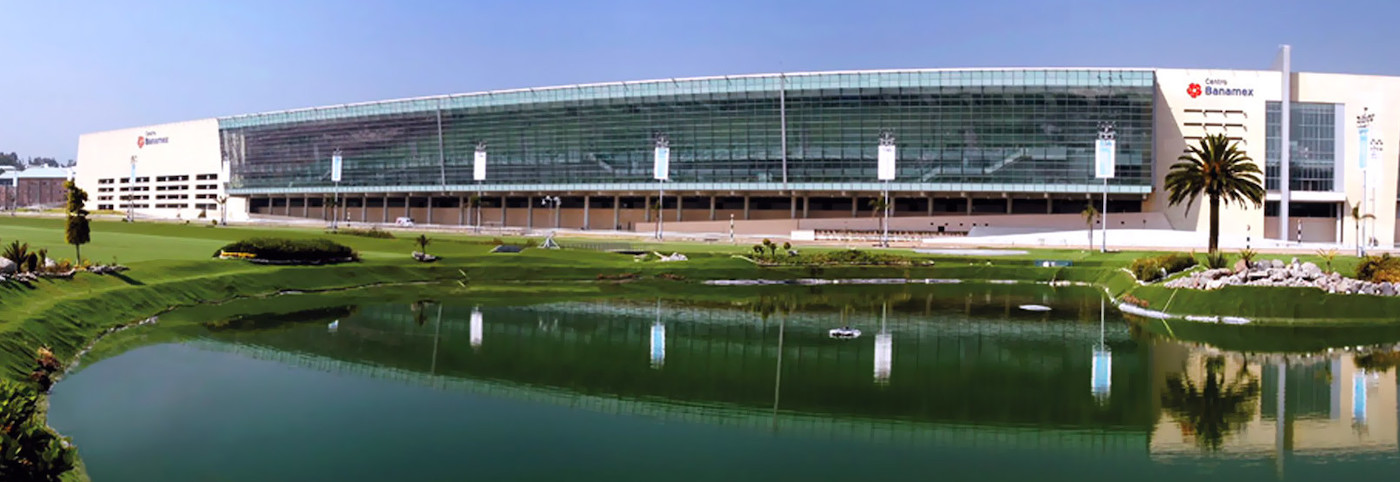
Map of CDMX (Mexico City)
Public Transportation in CDMX
Guided Tours in CDMX
Flights & Hotels in MEXICO CITY (CDMX)
More Tourist Attractions in MEXICO

States Of Mexico
Mexico has an incredible diversity of landscapes, where the beauty of its beaches, internationally recognized, stands out. In its vast territory of coasts, there are beaches of unparalleled beauty, and colorful landscapes. A large network of first-class hotels and tourist services is available to visitors to these beaches. Mexico is also mystical places, dotted with archaeological testimonies inherited from its original inhabitants. Monuments made by the Mayas, Aztecs and Toltecs are located in magical landscapes, like lighthouses in an ocean of natural beauty. They offer visitors buildings that tell their history, and museums that collect their cultural heritage. And that keep alive ancestral traditions, in ceremonies and festivals, where you can enjoy cultural activities and entertainment.… Read More

Capital Cities
Folklore, gastronomy, literary culture, art and exhibitions, is what you will find in the capitals of the states of Mexico. To the north, colonial Mexico, Puebla, Guadalajara, Guanajuato, the Sonoran desert and the California peninsula. To the east Veracruz and the gulf. To the west Acapulco, Oaxaca and Tuxtla Gutiérrez. And to the south the Riviera Maya and the pyramids of Chichén-Itzá, Tulúm and Cobá in Yucatán, Palenque in Chiapas, the cenotes, and the Central American jungles.… Read More

Ecotourism and Adventure
Mexico is one of the best countries for Ecotourism as it has a great variety of flora and fauna, as well as a large number of refuges for extraordinary species. You can enjoy recreational activities of appreciation and knowledge of nature through contact with it, such as: stargazing, observation of natural attractions, wildlife and bird watching. Throughout México there are more than 176 protected natural areas, 5 of them considered by UNESCO as Natural Heritage of Humanity. Just for this and much more, we believe that Mexico is a Paradise for Ecotourism.… Read More

Gastronomy
The Gastronomy of Mexico has a great diversity of typical dishes, which is why it was recognized by UNESCO as Intangible Heritage of Humanity. The basic and representative ingredients of Mexican dishes are: corn, coriander, chili, beans, piloncillo, nopal and tomato. Mexican cuisine is also characterized by its sauces, which serve as an accompaniment to traditional dishes, prepared based on spices.… Read More

Archaeological Sites
The Archaeological Zones are the cultural past of every Mexican. You will be amazed at the ambient, nature and the environment that surrounds them. Climbing to the top or being around it will take us back in time to admire every detail. México is a country of culture and traditions, many of which we have inherited from the pre-Hispanic inhabitants of this vast territory, although it is true that there were more settlements in the central and southern part of the country, it is also possible to find some archaeological remains in the north.
… Read More

Beaches
On the Beaches of Mexico you can immerse yourself in the intense blue ocean of the Pacific bays, sunbathe on the shore of the warm and transparent waves of the Caribbean Sea in Quintana Roo or even rest on the beautiful coasts of the Gulf of Mexico. Mexican beaches hide wonderful secrets for the traveler. By visiting them, in addition to enjoying the excellent climate and water activities, you can discover splendid archaeological sites and interesting colonial cities without traveling long distances.… Read More

Traditions in Mexico
It is practically impossible to make a meticulous, and above all, accurate selection of the places to visit in Mexico. Each place that our country houses is unique and beautiful in its own way. Mexico, with its nearly 2 million km², has a large number of scenarios to offer, as well as endless activities to do. Do not lose your way and enter the places to visit in Mexico. In Mexico, apart from the beaches and its famous archaeological sites, there are many other really interesting sites and activities that you should know. In the surroundings of the main cities you will find places full of culture and tradition, where you can spend relaxing, interesting and fun vacations. On your trip through Mexico you cannot stop obtaining souvenirs, the crafts that are made here are of the highest quality and recognized worldwide. A shopping tour cannot be missed.… Read More

Magical Towns
A Magical Town is a place with symbols and legends, towns with history that in many cases have been the scene of transcendent events for our country, they are places that show the national identity in each of its corners, with a magic that emanates from its attractions ; visiting them is an opportunity to discover the charm of Mexico. The Magical Towns Program contributes to revalue a set of populations in the country that have always been in the collective imagination of the nation and that represent fresh and varied alternatives for national and foreign visitors. A town that through time and in the face of modernity, has conserved, valued and defended its historical, cultural and natural heritage; and manifests it in various expressions through its tangible and intangible heritage. A Magical Town is a town that has unique, symbolic attributes, authentic stories, transcendent events, everyday life, which means a great opportunity for tourist use, taking into account the motivations and needs of travelers.… Read More


Buenos dias,
I will be traveling to Mexico on a 9 day tour from Mexico City to Cancun in early March.
I will be spending a few days in Mexico City on my own.
Do you have any brochures to include independent transportation and tours to Coyoacan and Xochimilco?
Recommended restaurants and taco stands would also be appreciated.
Please respond and I will give my mailing address.
Thanking you in advance.
Hi Maria,
Thank you for your interest in tours in Coyoacan and Xochimilco. We are glad to hear that you will be visiting Mexico City on your upcoming trip.
There are a variety of tour options available that include independent transportation and the opportunity to explore the unique neighborhoods of Coyoacan and Xochimilco. We suggest you to take a look at this link where you will find more information about the tours, including their itineraries and pricing.
Thank you for choosing us, we look forward to helping you plan your visit to Mexico City.
Best regards.
I wanted to thank you for the wonderful work you do, great information of everything you can possibly do in the city, I’m planning our trip of a full week in Ciudad de México following Your recommendations.
Thanks!